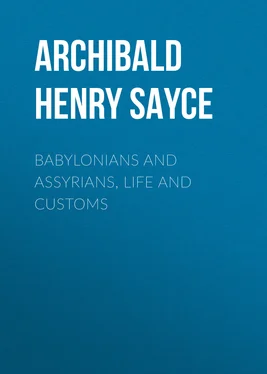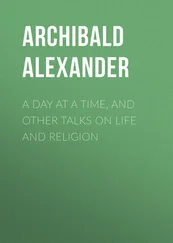Archibald Henry Sayce - Babylonians and Assyrians, Life and Customs
Здесь есть возможность читать онлайн «Archibald Henry Sayce - Babylonians and Assyrians, Life and Customs» — ознакомительный отрывок электронной книги совершенно бесплатно, а после прочтения отрывка купить полную версию. В некоторых случаях можно слушать аудио, скачать через торрент в формате fb2 и присутствует краткое содержание. Жанр: foreign_prose, История, foreign_edu, foreign_antique, на английском языке. Описание произведения, (предисловие) а так же отзывы посетителей доступны на портале библиотеки ЛибКат.
- Название:Babylonians and Assyrians, Life and Customs
- Автор:
- Жанр:
- Год:неизвестен
- ISBN:нет данных
- Рейтинг книги:5 / 5. Голосов: 1
-
Избранное:Добавить в избранное
- Отзывы:
-
Ваша оценка:
- 100
- 1
- 2
- 3
- 4
- 5
Babylonians and Assyrians, Life and Customs: краткое содержание, описание и аннотация
Предлагаем к чтению аннотацию, описание, краткое содержание или предисловие (зависит от того, что написал сам автор книги «Babylonians and Assyrians, Life and Customs»). Если вы не нашли необходимую информацию о книге — напишите в комментариях, мы постараемся отыскать её.
Babylonians and Assyrians, Life and Customs — читать онлайн ознакомительный отрывок
Ниже представлен текст книги, разбитый по страницам. Система сохранения места последней прочитанной страницы, позволяет с удобством читать онлайн бесплатно книгу «Babylonians and Assyrians, Life and Customs», без необходимости каждый раз заново искать на чём Вы остановились. Поставьте закладку, и сможете в любой момент перейти на страницу, на которой закончили чтение.
Интервал:
Закладка:
This is a very astonishing fact in a country where polygamy was allowed. It proves that polygamy was greatly restricted in practice, and that the tendency of the law was to forbid it altogether. Among the multitudinous contracts of the second Babylonian empire it is difficult to find any which show that a man had two legitimate wives living at one and the same time. The high position of the mother of the family, her independence and commercial equality with her husband, were all against it. It is only where the wife is a bought slave that polygamy can flourish.
In early times, it is true, the rich Babylonian indulged in the possession of more than one wife. Some contracts of the age of Khammurabi, translated by Mr. Pinches, are particularly instructive in this respect. We hear in them of a certain Arad-Samas, who first married a lady called Taram-Sagila and then her adopted sister Iltani. Iltani, it is ordained, shall be under the orders of her sister, shall prepare her food, carry her chair to the Temple of Merodach, and obey her in all things. Not a word is said about the divorce of the first wife; it is taken for granted that she is to remain at the head of the household, the younger and second wife acting as her servant. The position of Iltani, in fact, is not very different from that of a slave, and it is significant that neither wife brought a dowry with her.
As we have seen in the case of Dagil-ili, the law and custom of later Babylonia display a complete change of feeling and practice. Marriage with a second wife came to involve, as a matter of course, divorce from the first, even where there had been a mésalliance and the first wife had been without a dowry. The woman had thus gained a second victory; the rule that bound her in regard to marriage was now applied to the man. The privilege of marrying two husbands at once had been denied her; usage was now denying a similar privilege to him. It was only when the first wife was dead or divorced that a second could be taken; the wife might have a successor, but not a rival.
The divorced wife was regarded by the law as a widow, and could therefore marry again. A deed of divorce, dated in the reign of the father of Khammurabi, expressly grants her this right. To the remarriage of the widow there was naturally no bar; but the children by the two marriages belonged to different families, and were kept carefully distinct. This is illustrated by a curious deed drawn up at Babylon, in the ninth year of Nabonidos. A certain Bel-Katsir, who had been adopted by his uncle, married a widow who already had a son. She bore him no children, however, and he accordingly asked the permission of his uncle to adopt his step-son, thereby making him the heir of his uncle's property. To this the uncle objected, and it was finally agreed that if Bel-Katsir had no child he was to adopt his own brother, and so secure the succession of the estate to a member of his own family. The property of the mother probably went to her son; but she had the power to leave it as she liked. This may be gathered from a will, dated in the seventh year of Cyrus, in which a son leaves property to his father in case of death, which had come to him from his maternal grandfather and grandmother. The property had been specially bequeathed to him, doubtless after his mother's death, the grandmother passing over the rest of her descendants in his favor.
The marriage ceremony was partly religious, partly civil; no marriage was legally valid without a contract duly attested and signed. The Babylonians carried their business habits into all departments of life, and in the eyes of the law matrimony was a legal contract, the forms of which had to be duly observed. In the later days of Babylonian history the legal and civil aspect of the rite seems to have been exclusively considered, but at an earlier period it required also the sanction of religion; and Mr. Pinches has published a fragmentary Sumerian text in which the religious ceremony is described. Those who officiated at it, first placed their hands and feet against the hands and feet of the bridegroom, then the bride laid her neck by the side of his, and he was made to say to her: “Silver and gold shall fill thy lap; thou art my wife; I am thy husband. Like the fruit of an orchard will I give thee offspring.” Next came the ceremony of binding the sandals on the feet of the newly wedded pair and of handing them the latchet wherewith the shoes should be tied, as well as “a purse of silver and gold.” The purse perhaps symbolized the dowry, which was given by the father of the bride. In the time of Nebuchadnezzar the ceremony was restricted to joining together the hands of the bride and bridegroom.
Contact with the Assyrians and Babylonians in the Exilic period introduced the Babylonian conception of the legal character of marriage among the Israelites, and, contrary to the older custom, it became necessary that it should be attested by a written contract. Thus, Raguel, when he gave his daughter “to be wife to Tobias,” “called Edna, his wife, and took paper and did write an instrument of covenants, and sealed it” (Tobit vii. 14).
According to Herodotus, a gigantic system of public prostitution prevailed in Babylonia. Every unmarried woman was compelled to remain in the sacred enclosure of Mylitta—by which Istar is apparently meant—until some stranger had submitted to her embraces, while the sums derived from the sale of their personal charms by the handsome and good-looking provided portions for the ugly. Of all this there is not a trace in the mass of native documents which we now possess. There were the devotees of Istar, certainly—the ukhâtu and kharimâtu —as well as public prostitutes, who were under the protection of the law; but they formed a class apart, and had nothing to do with the respectable women of the country. On the contrary, in the age of Khammurabi it was customary to state in the marriage contracts that no stain whatever rested on the bride. Thus we read in one of them: “Ana-Â-uzni is the daughter of Salimat. Salimat has given her a dowry, and has offered her in marriage to Bel-sunu, the son of the artisan. Ana-Â-uzni is pure; no one has anything against her.” The dowry, as we have seen, was paid by the near relations of the wife, and where there was none, as in the case of the singing-woman married by Nebo-akhi-iddin, there was no dowry at all. The dowries provided for the ugly by the prostitution of the rich must be an invention of the Greeks.
Within what degree of relationship marriage was permitted is uncertain. A man could marry his sister-in-law, as among the Israelites, and, in one instance, we hear of marriage with a niece. In the time of Cambyses a brother marries his half-sister by the same father; but this was probably an imitation of the Persian custom.
The children, as we have seen, whether boys or girls, inherited alike, subject to the provisions of the parent's will. The will seems to have been of Babylonian origin. Testamentary devolution of property went back to an early period in a country in which the legal relations of trade had been so fully developed. Trade implied private property and the idea of individual possession. The estate belonging to a person was his absolutely, to deal with pretty much as he would. He had the same right to alienate it as he had to increase it. In a commercial community there could be no community of goods.
As far back, therefore, as our materials carry us, the unit in the Babylonian state is the individual rather than the family. It is he with whom both the law and the government deal, and the legal code of Babylonia is based upon the doctrine of individual responsibility. Private ownership is the key-note of Babylonian social life.
But the whole of this social life was fenced about by a written law. No title was valid for which a written document could not be produced, drawn up and attested in legal forms. The extensive commercial transactions of the Babylonians made this necessary, and the commercial spirit dominated Babylonian society. The scribe and the lawyer were needed at almost every juncture of life.
Читать дальшеИнтервал:
Закладка:
Похожие книги на «Babylonians and Assyrians, Life and Customs»
Представляем Вашему вниманию похожие книги на «Babylonians and Assyrians, Life and Customs» списком для выбора. Мы отобрали схожую по названию и смыслу литературу в надежде предоставить читателям больше вариантов отыскать новые, интересные, ещё непрочитанные произведения.
Обсуждение, отзывы о книге «Babylonians and Assyrians, Life and Customs» и просто собственные мнения читателей. Оставьте ваши комментарии, напишите, что Вы думаете о произведении, его смысле или главных героях. Укажите что конкретно понравилось, а что нет, и почему Вы так считаете.












